Bengal cats captivate cat lovers with their exotic appearance, energetic personalities, and affectionate nature. Their striking spotted or marbled coat, inherited from their wild ancestor, the Asian leopard cat, sets them apart from other domestic cat breeds. Bengal cats don’t just look wild—they act the part too, displaying unmatched intelligence, high energy, and a playful spirit that keeps their owners endlessly entertained.
People who bring a Bengal cat into their home quickly realize they aren’t just getting a pet—they’re gaining an interactive, loving, and sometimes mischievous companion. These cats form deep bonds with their humans, follow them from room to room, and even enjoy learning tricks. Their love for climbing, jumping, and exploring means they require more engagement than the average cat. Owners often describe Bengals as part dog, part athlete, and part genius, making them one of the most fascinating cat breeds in the world.
In this post, we’ll explore the top seven reasons Bengal cat owners are absolutely obsessed with these unique felines. From their stunning wild looks to their affectionate personalities, you’ll discover why Bengals have such a devoted following. Whether you’re considering adoption or already own one of these incredible cats, this guide will give you a deeper appreciation for what makes them so special.
Stunning Wild Ancestry & Unique Appearance
The Bengal Cat: Wild Cat Ancestry
Bengal cats have a direct link to the wild, making them one of the most exotic-looking domestic cat breeds. Breeders created this unique breed by crossing the Asian leopard cat with domestic cats, resulting in a feline that carries the beauty and elegance of its wild ancestors while maintaining the affectionate and social traits of a house cat. This ancestry gives the Bengal cat its signature athletic build, sleek coat, and incredible agility.
Unlike typical house cats, Bengals inherit natural instincts from their wild lineage. They love climbing to high places, exploring new territories, and engaging in activities that challenge their intelligence. Their sharp hunting instincts make them quick and precise when playing with toys or chasing moving objects. Because of their energetic nature, Bengal cats require more mental and physical stimulation than the average cat, making interactive play an essential part of their daily routine.
Spotted Coat Pattern
One of the most striking features of a Bengal cat is its beautifully patterned coat, which closely resembles that of a leopard. The breed’s distinct spotted coat pattern comes in various shades, including golden, brown, silver, and even snow. These markings make Bengals look like miniature jungle cats, adding to their wild and exotic charm.
Unlike the solid-colored coats of many domestic cat breeds, Bengals have intricate spots, rosettes, or marbled patterns that create a unique, high-contrast look. Their coats shimmer under the light due to a special gene that gives their fur an iridescent “glitter” effect, making them appear even more stunning. This luxurious coat makes Bengal cats a favorite among pet owners who appreciate both beauty and uniqueness in their feline companions.
Hypoallergenic Qualities of the Bengal Cat
Many people who suffer from cat allergies are drawn to Bengal cats because they are often considered a hypoallergenic cat breed. While no cat is truly 100% hypoallergenic, Bengals produce lower levels of the allergenic protein Fel d 1, which is responsible for triggering allergic reactions in humans. This means some allergy sufferers may find Bengals easier to tolerate compared to other breeds.
Another reason Bengals might be better for allergy sufferers is their short, sleek coat, which requires minimal grooming. Because their fur doesn’t mat easily and they shed less than long-haired cats, there is less dander and loose hair floating around the home. Regular brushing and proper hygiene can further reduce allergens, making Bengals a great choice for cat lovers with mild allergies.
These unique traits—wild ancestry, an eye-catching spotted coat, and potential hypoallergenic qualities—set Bengal cats apart from other breeds and make them a top choice for people who want an exotic-looking, intelligent, and energetic feline companion.
Intelligent & Highly Trainable Cats
Bengal Cat Intelligence
A Bengal cat isn’t just a beautiful feline—it’s one of the smartest domestic cat breeds. This breed stands out for its problem-solving skills, curiosity, and ability to learn quickly. Bengal cats don’t just observe their surroundings; they analyze them, often figuring out how to open doors, turn on faucets, or retrieve hidden toys. Their intelligence makes them fascinating companions, but it also means they need constant mental stimulation to stay happy.
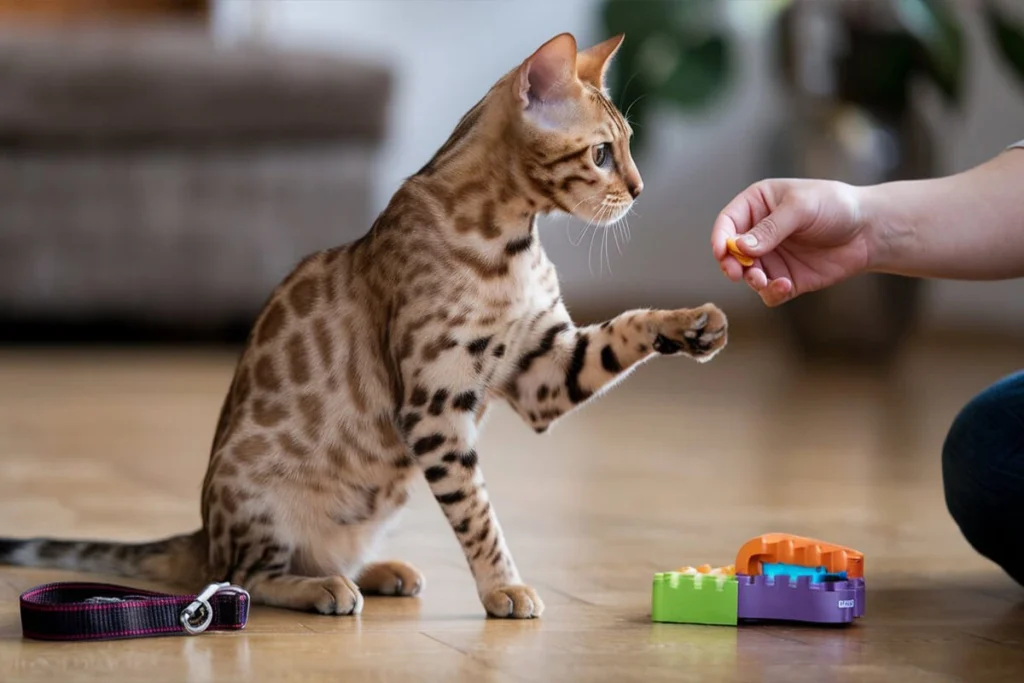
Because of their sharp minds, Bengal cats tend to be more interactive than the average house cat. They don’t just sit idly on a windowsill—they actively seek engagement, whether it’s chasing moving objects, figuring out how to get into a cupboard, or even mimicking their owner’s behavior. Some Bengal owners report that their cats can learn routines, understand certain words, and even recognize specific sounds, such as the jingling of car keys or the opening of a treat jar. If a Bengal cat doesn’t receive enough intellectual stimulation, it may resort to mischief, like unrolling toilet paper, knocking over objects, or trying to escape its enclosure.
Bengal Cat Training
Because of their high intelligence, Bengal cats can be trained far more easily than many other domestic cat breeds. Unlike most cats that prefer independence, Bengals thrive on interactive training sessions and enjoy learning new skills. Many Bengal owners teach their cats to sit, give high-fives, and even perform agility tricks. Training a Bengal requires patience, consistency, and positive reinforcement, but these intelligent felines respond well to rewards like treats, praise, or playtime.
One of the most popular training activities for Bengals is leash training. Unlike many cats that resist wearing a harness, Bengals often enjoy the experience because it satisfies their natural urge to explore. Taking a Bengal cat for a walk allows it to safely investigate the outside world while getting exercise. Bengals also enjoy fetch, similar to dogs, and can learn to retrieve toys and bring them back to their owner. Clicker training works exceptionally well with Bengals because they quickly associate the sound with a reward, making it easier to teach them behaviors like coming when called or using a scratching post instead of furniture.
Without proper training, a Bengal cat might develop bad habits, such as excessive meowing, scratching furniture, or getting into places it shouldn’t. Setting clear boundaries early on and providing structured training sessions can prevent behavioral issues while strengthening the bond between the cat and its owner.
Puzzle Toys & Mental Stimulation
Keeping a Bengal cat mentally engaged is just as important as giving it physical exercise. These cats crave mental challenges, and puzzle toys provide the perfect way to satisfy their need for stimulation. Unlike typical cats that may bat at a ball a few times before losing interest, Bengals actively work to solve puzzles, often spending long periods trying to unlock hidden treats or manipulate interactive objects.
Some of the best puzzle toys for Bengal cats include:
- Treat-dispensing balls – Bengals enjoy rolling these around to get food rewards.
- Interactive feeding puzzles – These encourage problem-solving by making the cat figure out how to access its meal.
- Electronic motion toys – Moving toys, such as robotic mice or spinning feather teasers, keep a Bengal entertained for hours.
- DIY puzzle boxes – A simple cardboard box with holes and hidden treats can provide an excellent mental workout.
Because of their intelligence and high energy, Bengal cats need a combination of interactive play, puzzle-solving, and training to stay happy and avoid boredom. Without proper stimulation, they might create their own “games”—such as opening drawers, turning on faucets, or knocking items off shelves. Owners who dedicate time to engaging their Bengal cat’s mind will find themselves rewarded with a playful, affectionate, and highly interactive companion.
Playful, Energetic, and Always Entertaining
High-Energy Cat Breed
A Bengal cat isn’t the type to lounge around all day like a typical house cat. This breed bursts with energy, always seeking movement, excitement, and adventure. Bengals come from a lineage that includes the wild Asian leopard cat, which explains their athleticism, agility, and strong prey drive. They love running, climbing, jumping, and exploring every inch of their environment. Owners who bring a Bengal into their home must be prepared for a cat that demands constant activity and engagement.
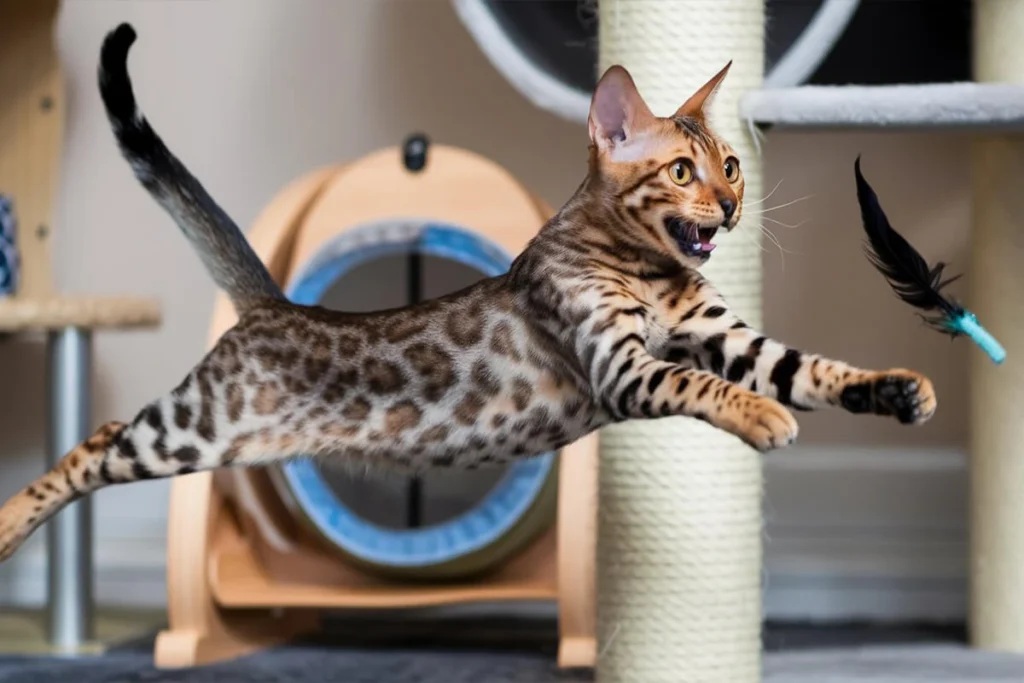
Because of their high-energy nature, Bengal cats require plenty of space to roam. They thrive in homes with tall cat trees, shelves, and interactive play areas. Bengals don’t just enjoy climbing—they need it. Many owners install wall-mounted perches, ceiling hammocks, and large scratching posts to satisfy their Bengal cat’s natural instincts. Without enough outlets for their energy, Bengals may resort to destructive behaviors like scratching furniture, knocking over objects, or zooming around the house at top speed.
Bengals also excel in feline agility and enjoy obstacle courses. Some owners even build custom play areas with tunnels, ramps, and platforms to keep their Bengal entertained. If left alone for too long without stimulation, a Bengal cat may become restless, vocal, or mischievous, searching for ways to entertain itself. Providing structured playtime and activities helps channel this energy in a positive direction.
Interactive Cat Toys
A Bengal cat doesn’t just play—it hunts, pounces, and strategizes during playtime. Regular toys like stuffed mice or simple balls won’t be enough to keep a Bengal engaged. These cats need interactive cat toys that challenge their intelligence and satisfy their natural instincts. Bengals love toys that mimic real prey, encourage problem-solving, or involve direct interaction with their owners.
Some of the best interactive cat toys for Bengals include:
- Feather wands and teaser toys – Bengals love to stalk, chase, and leap after these. Owners can simulate real hunting experiences by moving the toy unpredictably.
- Laser pointers – These keep a Bengal cat engaged as it chases the moving light. However, owners should end the game with a tangible toy or treat to avoid frustration.
- Electronic motion toys – Battery-powered mice, spinning feather toys, or robotic bugs trigger a Bengal’s hunting instincts.
- Treat-dispensing puzzle toys – Bengals enjoy solving puzzles to access hidden treats, keeping their minds engaged while satisfying their food motivation.
- Cat exercise wheels – Many Bengals enjoy running on a wheel, which helps them burn energy and stay fit.
Since Bengals need frequent and intense play sessions, rotating toys and introducing new challenges will keep them interested. Playtime isn’t just fun for Bengals—it’s a necessity. Without regular interactive play, a Bengal cat might become bored, frustrated, or overly demanding, looking for ways to release its pent-up energy.
Vocal & Expressive
A Bengal cat doesn’t stay quiet when it wants something. This breed is known for being highly vocal and expressive, often communicating through a variety of meows, chirps, and trills. Unlike some cats that only vocalize when hungry, Bengals “talk” throughout the day, letting their owners know exactly how they feel. They express excitement, curiosity, and even complaints through their unique vocalizations.
Many Bengal owners describe their cats as having a wide range of sounds, from soft chirps when they spot something interesting to loud, demanding meows when they want attention. Bengals often “talk back” when spoken to, making conversations with them entertaining and engaging. Some even respond with different tones depending on their mood—excited trills when playing, sharp meows when impatient, and soft purrs when content.
Bengals also use body language to communicate. They flick their tails, arch their backs, and make direct eye contact when expressing emotions. If a Bengal cat wants to play, it may crouch in a playful stance and let out a chirping sound. If it feels ignored, it might follow its owner around, meowing persistently until it gets attention.
Because of their vocal nature, Bengals may not be the best choice for someone who prefers a quiet pet. Their expressive personalities make them fun and engaging companions, but owners should be prepared for a cat that enjoys frequent communication. If a Bengal suddenly becomes silent, it could indicate boredom or unhappiness, so interactive play and social interaction remain essential for keeping a Bengal cat happy.
Affectionate & Loyal Companions
Bengal Cat Affection
A Bengal cat doesn’t just tolerate human interaction—it actively seeks it. Unlike some independent domestic cat breeds, Bengals crave attention and love forming strong bonds with their owners. Many Bengal cats follow their humans from room to room, always wanting to be part of the action. Whether it’s curling up next to their owner on the couch, rubbing against their legs, or climbing onto their shoulders, Bengals find unique ways to express their affection.
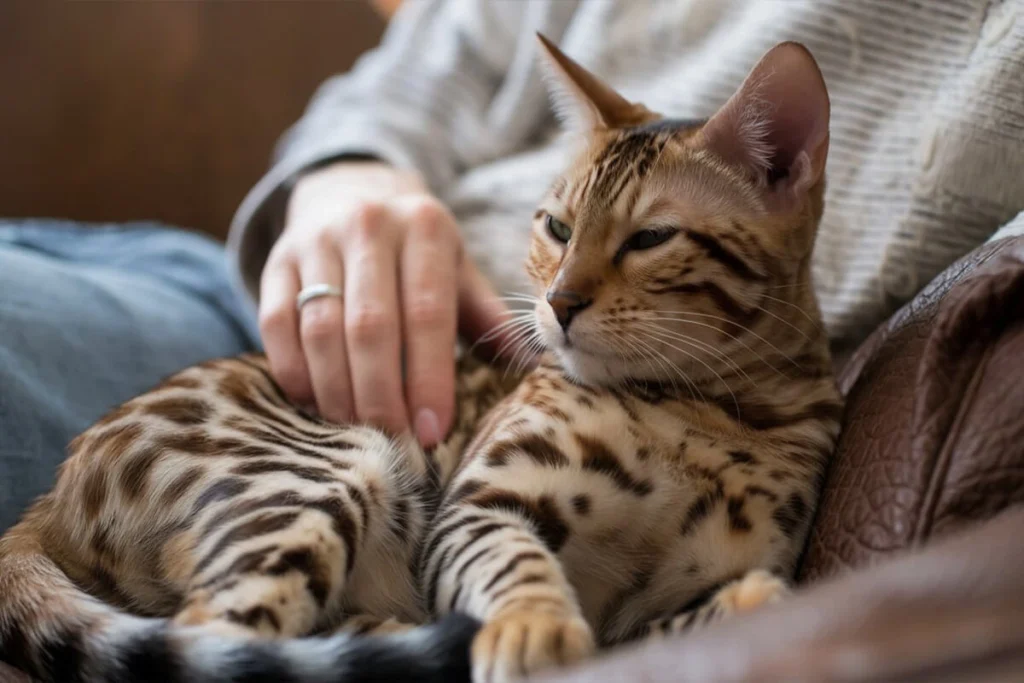
These cats enjoy physical contact but prefer interactive affection over passive cuddling. While some Bengals love being held, others prefer to show love by sitting nearby, nudging their owner with their head, or playfully tapping them with a paw. They often greet their humans at the door after a long day, chirping and meowing as if asking where they’ve been. Unlike aloof cats that hide when guests arrive, Bengals often approach new people with curiosity, showing off their social and affectionate nature.
Many Bengal owners describe their cats as “dog-like” because of how much they enjoy companionship. They don’t just want food and shelter—they want engagement, play, and love from their owners. A Bengal cat that receives regular attention and affection will develop a deep, trusting bond and become a loyal companion.
Social & Loving Nature
A Bengal cat thrives in a social environment where it feels included and involved. These cats don’t enjoy isolation and may become restless or vocal if left alone for too long. Bengals love being around their family members, whether they are playing, lounging, or even working on a laptop. If ignored, a Bengal will often remind its owner of its presence by meowing, tapping their hand, or bringing a toy as an invitation to play.
Because of their social personality, Bengals do well in homes where they receive plenty of interaction. They enjoy engaging with multiple family members and even learn to recognize different people’s voices and habits. Some Bengals develop a strong attachment to one specific person, following them everywhere and demanding their attention. Others spread their love equally, making them affectionate with everyone in the household.
Bengals also enjoy routines and quickly learn their family’s daily schedule. If an owner feeds them at a specific time every morning, the Bengal will expect consistency and might “remind” them with persistent meows if they’re late. They also enjoy being involved in household activities, whether it’s watching their owner cook, “helping” with laundry, or sitting nearby during family movie nights.
Because Bengals thrive on social interaction, they may not be the best choice for someone who spends long hours away from home. If left alone too often, a Bengal cat may develop attention-seeking behaviors, such as excessive meowing, knocking objects off shelves, or getting into places it shouldn’t. Providing interactive toys, puzzle feeders, or even adopting a second pet can help keep a Bengal cat happy when its owner isn’t around.
Great with Families & Other Pets
A Bengal cat fits well into family life, especially when properly socialized. These cats enjoy the hustle and bustle of a lively household, and they bond well with children, other cats, and even dogs. Their playful and energetic nature makes them great companions for kids who enjoy interactive play. Because Bengals are intelligent, they quickly learn how to engage with children, often adapting their energy levels based on how gentle or active their playmates are.
When introduced correctly, Bengals can also get along well with other pets. Many Bengal cats develop strong bonds with other felines, especially if they have a playmate with a similar energy level. They enjoy chasing, wrestling, and playing with other cats, forming deep friendships that help keep them mentally and physically stimulated. Some Bengal cats even establish dominance in a multi-cat household, using playful but firm behavior to show they’re in charge.
Bengals also tend to get along with dogs, particularly active breeds that enjoy play. Their confident personality allows them to stand their ground, and their natural curiosity often leads them to investigate and interact with canine companions. Many Bengal owners find that their cat and dog become best friends, playing chase, sharing sunny spots, and even sleeping next to each other.
However, because Bengals have a strong prey drive, they may not be the best match for small pets like birds, hamsters, or fish. Their hunting instincts can take over, leading them to stalk or attempt to “catch” smaller animals. Owners with small pets should ensure they keep them in secure enclosures away from the Bengal’s reach.
Important Considerations Before Adoption
Bengal Cat Care
Providing proper Bengal cat care ensures a happy, healthy, and well-adjusted feline companion. Bengals require more attention than the average house cat due to their high energy, intelligence, and social nature. Owners must commit to regular playtime, a high-quality diet, grooming, and a stimulating environment to keep their Bengal content.
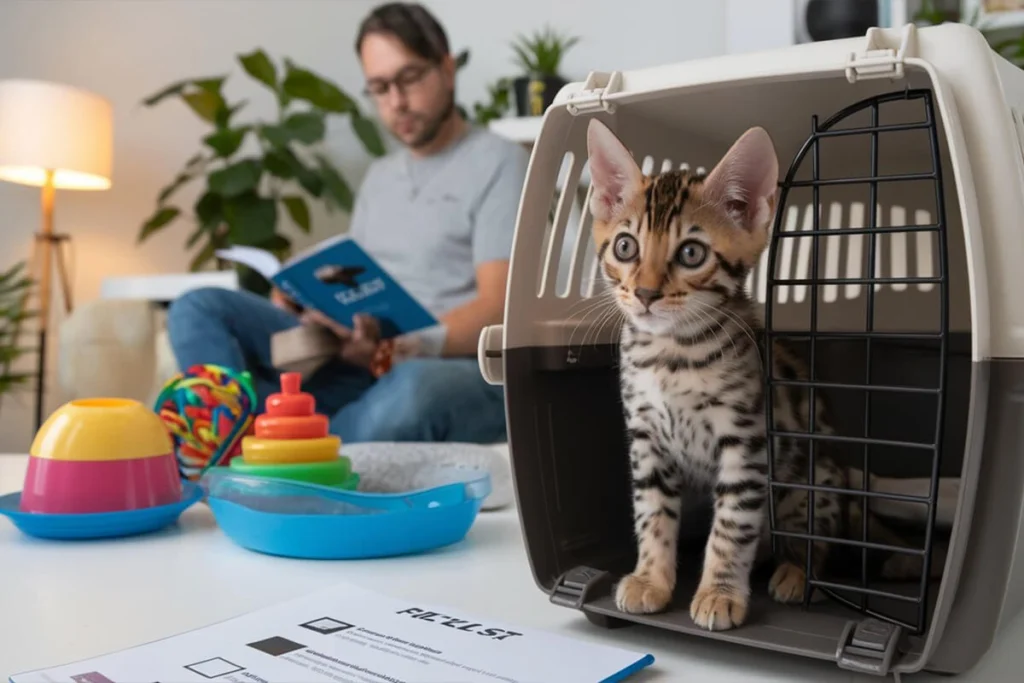
Diet & Nutrition
A Bengal cat thrives on a protein-rich diet that supports its lean, muscular body and high activity levels. Since Bengals descend from wild ancestors, they do best with high-quality, grain-free cat food that mimics a natural carnivorous diet. Many owners feed their Bengals raw or freeze-dried food, but high-protein wet or dry food with real meat as the main ingredient also provides proper nutrition. Hydration is essential, so providing fresh water or a cat fountain encourages drinking.
Grooming Needs
Unlike long-haired domestic cat breeds, a Bengal’s short, sleek coat requires minimal grooming. Their fur has a soft, luxurious texture that doesn’t mat easily, but occasional brushing removes loose hair and keeps their coat shiny. Because Bengals groom themselves frequently, they rarely develop strong odors. However, regular nail trimming, ear cleaning, and dental care help maintain overall health.
Exercise & Mental Stimulation
Since a Bengal cat belongs to the category of high-energy cat breeds, it requires daily exercise and mental challenges. Bengals enjoy interactive play sessions with toys that mimic hunting, such as feather wands, laser pointers, or robotic mice. Large cat trees, climbing shelves, and scratching posts help satisfy their need to climb and explore. Puzzle toys and food-dispensing games keep them mentally engaged, preventing boredom and destructive behavior.
Routine Vet Visits
Regular veterinary check-ups help keep a Bengal healthy. While Bengals are generally robust, they can develop genetic conditions such as hypertrophic cardiomyopathy (HCM), a heart disease common in some purebred cats. Routine vaccinations, flea prevention, and parasite control also contribute to long-term well-being. Because of their intelligence and curiosity, Bengals may get into trouble by chewing on dangerous objects or climbing into unsafe spaces, so cat-proofing the home is an essential part of Bengal cat care.
Bengal Cat Cost
Owning a Bengal cat requires a financial commitment beyond the initial purchase or adoption fee. Bengals are premium, exotic cats with a price that reflects their rarity, wild ancestry, and high demand. The cost of acquiring and maintaining a Bengal includes breeder prices, healthcare, food, and enrichment.
Price of a Bengal Cat from a Breeder
A Bengal kitten from a reputable breeder typically costs between $1,500 and $3,000, depending on pedigree, coat markings, and breeder reputation. Show-quality Bengals with rare coat patterns, such as silver or snow Bengals, can cost even more. Ethical breeders perform genetic testing, provide vaccinations, and offer a health guarantee, which justifies the higher price.
Additional Costs
The expenses of owning a Bengal cat go beyond the purchase price. Owners should budget for:
- High-quality food – Bengals require premium, high-protein diets, which can cost $30–$80 per month.
- Veterinary care – Annual check-ups, vaccinations, and potential emergencies can add up to $200–$500 per year.
- Interactive toys & enrichment – Bengals need regular mental stimulation, so puzzle toys, climbing structures, and scratching posts are essential. Initial costs for enrichment can range from $100 to $500.
- Pet insurance – Due to their active nature and potential for genetic health issues, some owners invest in pet insurance, which can cost $20–$50 per month.
- Grooming & litter supplies – While Bengals require minimal grooming, quality litter, brushes, and nail clippers add to regular expenses.
Because Bengal cats are highly intelligent and energetic, they can cause damage if they don’t receive enough attention or stimulation. Replacing scratched furniture or repairing damage from a bored Bengal can lead to additional unforeseen costs. Responsible Bengal ownership means budgeting for their needs and ensuring they have a stimulating environment.
Bengal Cat Adoption
For those who want to bring a Bengal cat into their home without purchasing from a breeder, adoption is a great option. Many Bengal cats end up in rescues or shelters due to their high energy and demanding nature. Prospective owners should research Bengal-specific rescues and consider adopting a Bengal in need of a second chance.
Why Do Bengals End Up in Shelters?
Bengals are beautiful and exotic, but their intelligence and activity levels make them a challenge for unprepared owners. Some common reasons Bengals are surrendered to shelters include:
- Owners underestimating their energy levels – Bengals require daily play, engagement, and mental stimulation, which some owners find overwhelming.
- Destructive behavior due to boredom – Without enough stimulation, Bengals may scratch furniture, open cabinets, or engage in excessive meowing.
- Household allergies – While Bengals are considered a hypoallergenic cat breed, some allergy sufferers may still react to them.
- Incompatibility with other pets – Bengals have strong personalities and high prey drives, which can create conflicts in multi-pet households.
How to Adopt a Bengal Cat
Finding a Bengal for adoption requires patience, but dedicated rescues and shelters often have Bengals in need of loving homes. Some ways to adopt include:
- Bengal-specific rescues – Organizations like Bengal Rescue specialize in rehoming Bengals and matching them with experienced owners.
- Local animal shelters – Occasionally, Bengals or Bengal mixes are surrendered to general shelters, so checking regularly increases the chances of finding one.
- Online pet adoption platforms – Websites like Petfinder and Adopt-a-Pet list Bengals available for adoption in various locations.
- Bengal owner networks & forums – Some Bengal owners rehome their cats through online communities and breed-specific groups.
Adoption Costs & Considerations
The cost of adopting a Bengal varies but is generally lower than purchasing from a breeder. Adoption fees range from $100 to $500, covering vaccinations, spaying/neutering, and initial vet care. Adopting a Bengal requires the same commitment to exercise, training, and engagement as purchasing a kitten from a breeder. Bengals need an active, involved owner who understands their unique personality.
Final Thoughts
A Bengal cat is more than just a pet—it is an active, intelligent, and affectionate companion that brings excitement into any home. Owners quickly become obsessed with their Bengal’s striking appearance, playful personality, and deep social bond. This breed thrives in a stimulating environment where it can climb, explore, and interact with its human family. Bengal cats form strong attachments to their owners, following them around the house, engaging in play, and communicating with their wide range of vocalizations.
Providing proper Bengal cat care ensures a happy and well-adjusted feline. Bengals need a protein-rich diet, regular veterinary check-ups, and plenty of physical and mental stimulation. Unlike more independent domestic cat breeds, Bengals crave attention and demand engagement. Without enough activity, they may resort to destructive behavior or excessive meowing. Investing in interactive cat toys, climbing structures, and training exercises helps channel their energy in a positive way.
Understanding Bengal cat cost is essential before bringing one home. The initial price, combined with ongoing expenses for food, veterinary care, and enrichment, makes Bengals a long-term financial commitment. For those looking to adopt, Bengal-specific rescues and shelters provide opportunities to give these incredible cats a second chance.
Owning a Bengal cat is a rewarding experience for those who appreciate their energetic nature, intelligence, and affectionate personality. With proper care, attention, and love, a Bengal becomes an entertaining, loyal, and endlessly fascinating companion. Whether purchased from a breeder or adopted from a rescue, a Bengal cat will transform any home into a lively and joyful space.
Discover The Actual Price of a Bengal Cat on this Ultimate Guide!
Read About The Chimera Cat Breed Here.
You can Pick the Best Name for your furry friend in this Lovely Guide!
Read About the Latest Tips For All Different Cats From HERE.
Can Cats Eat Cheese ? Read About this Topic on this Article.
Looking For Good stuff for your Cat? Look no Further and Visit Pet MD Official.
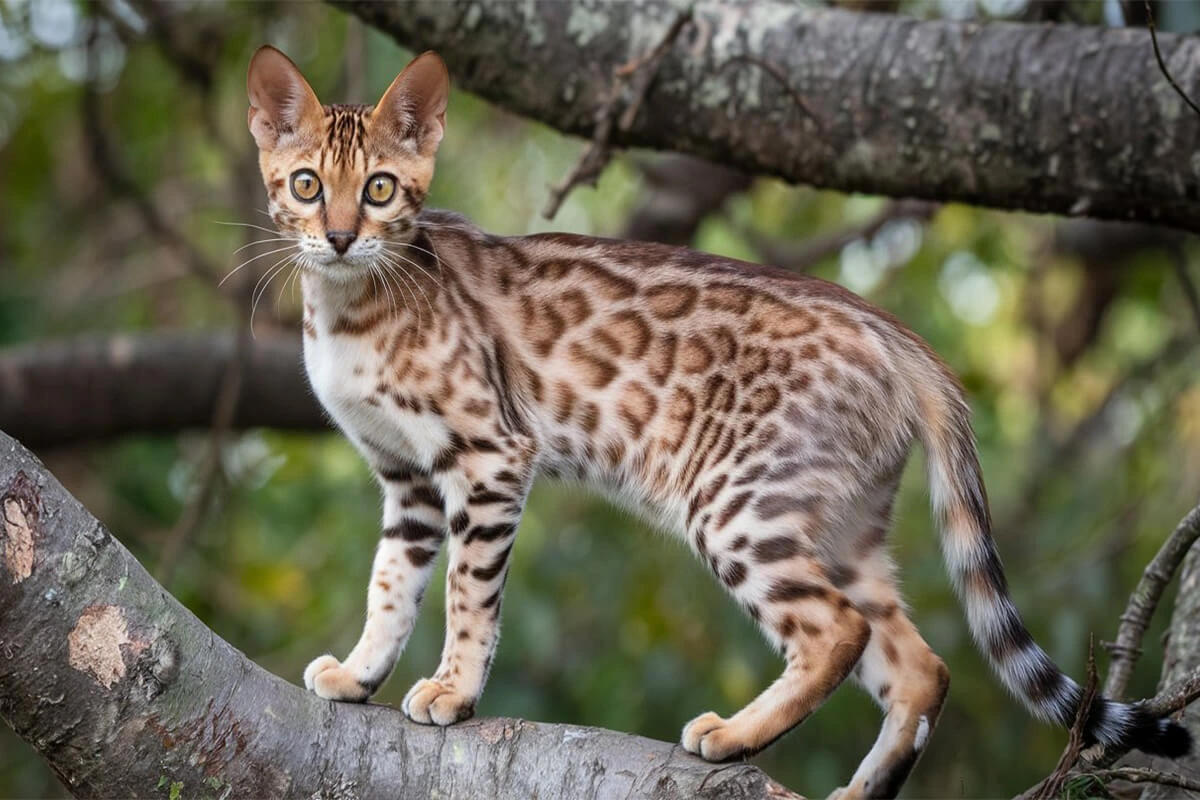
3 thoughts on “Bengal Cat Love: Top 7 Reasons Owners Are Obsessed”
Comments are closed.